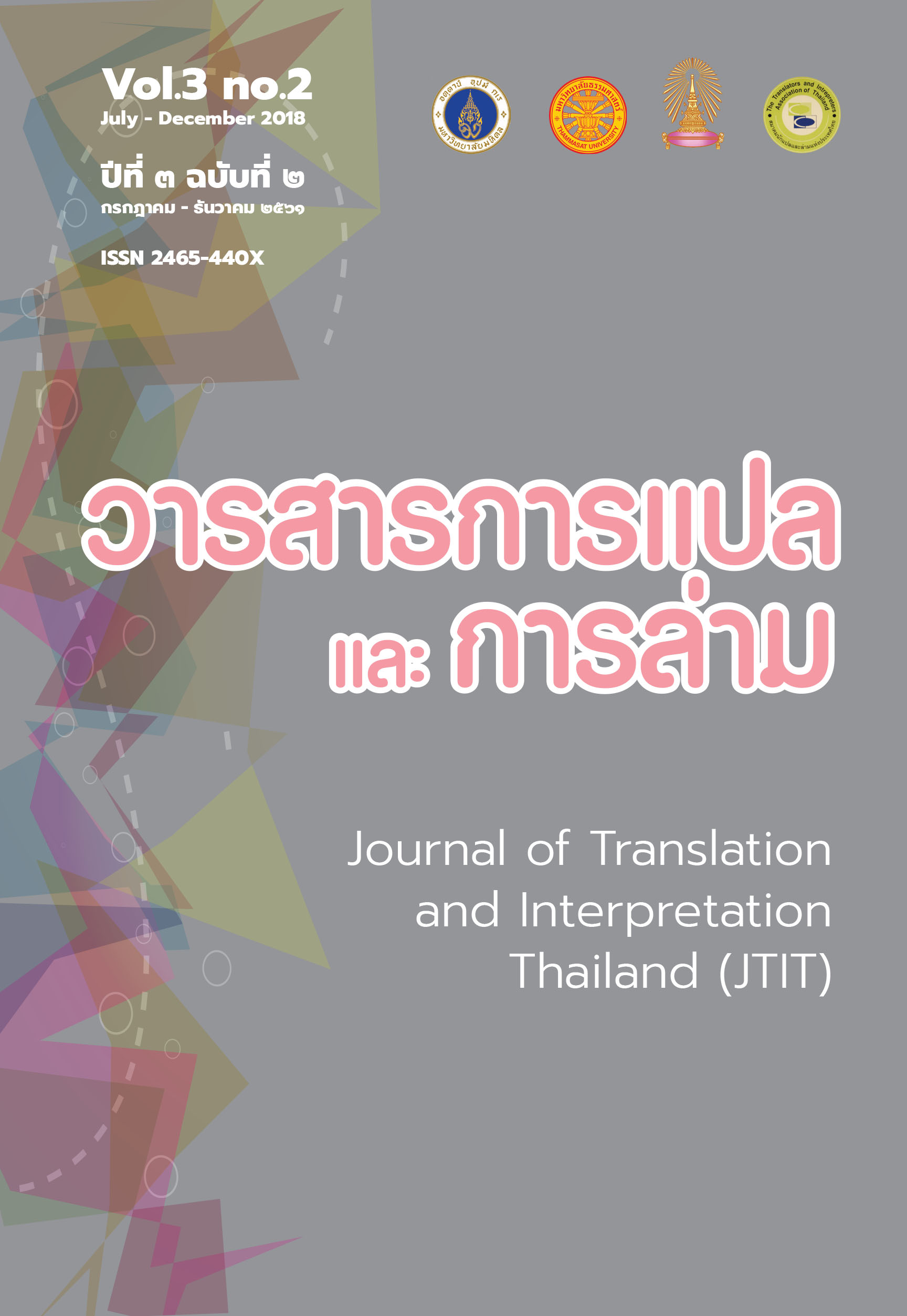เรื่องเพศกับการเซ็นเซอร์: การแปลภาษาต้องห้ามในนวนิยาย เรื่อง Fifty Shades of Grey ของ E. L. James
Main Article Content
Abstract
This study, conducted as a descriptive study of translation using cultural studies approach, aims to find out the ideological factors and the power of agents influencing translations under the assumption that translating processes are controlled by the power of agencies and the regulation of morals and norms in translation. The consequence of resolving the problems in translation reflects the ideologies effecting any utterances in the translation and leads to the mechanism of censorship under the strategies of translation, especially in the sexrelated issue, which is one of the most sensitive issues in our society.
The researcher reviews related and relevant concepts of translation theories, sex-related taboo languages and censorship in both the English and Thai languages. Selected excerpts from the English source text of Fifty Shades of Grey, written by E. L. James, and the translated text, translated by Nantaphon Pillay, were then analyzed along with reference to the interview of translator. The result of the study shows that the strategies of censorship of sex-related taboo languages seen in the translation of Fifty Shades of Grey are omission, partial translation, substitution, addition, and down toning or the use of euphemisms. The causes of these censorships are the internal and external translation constraints of translation, especially the power of agents in publishing
industry, such as the laws, publishers, and editors which are external translation constraints. The practices of these power could demonstrate the main ideology in Thai society that is influenced by Buddhism which is the principle religious of Thai society.
Article Details
References
ชลิดาภรณ์ ส่งสัมพันธ์. (2551). ประวัติศาสตร์ของเพศวิถี : ประวัติศาสตร์เรื่องเพศ/เรื่องเพศในประวัติศาสตร์ไทย. กรุงเทพฯ : มูลนิธิสร้างความเข้าใจเรื่องสุขภาพผู้หญิง (สคส.) และสถาบันวิจัยประชากรและสังคม (วปส) มหาวิทยาลัยมหิดล.
ณัฐพร พานโพธิ์ทอง. (2556). วาทกรรมวิเคราะห์เชิงวิพากษ์ตามแนวภาษาศาสตร์: แนวคิดและการนำมาศึกษาวาทกรรมในภาษาไทย. กรุงเทพฯ: โครงการเผยแพร่งานวิชาการคณะอักษรศาสตร์ จุฬาลงกรณ์มหาวิทยาลัย.
ดานีนเวิร์ม. (2556). Fifty Shades of Grey : อี แอล เจมส์ (E. L. James) – เมื่อฉบับแปลไทย …ไม่ได้หวือหวาอย่างที่หลายคนรอคอย. [ออนไลน์]. สืบค้น 12 พฤศจิกายน 2558, จาก https://danineworm.wordpress.com/2013/05/12/fifty-shades-ofgrey/
เถกิง พันธุ์เถกิงอมร. (2541). นวนิยายและเรื่องสั้น การศึกษาเชิงวิเคราะห์และวิจารณ์. สงขลา: คณะมนุษยศาสตร์และสังคมศาสตร์ สถาบันราชภัฏสงขลา.
ธนะชัย มีผดุง. (2539). มาตรการทางกฎหมายในการควบคุมการผลิตและเผยแพร่วัตถุหรือสิ่งของลามก. (วิทยานิพนธ์ปริญญามหาบัณฑิต). กรุงเทพฯ: จุฬาลงกรณ์มหาวิทยาลัย.
เมทัล บริดเจส. (2558). Fifty Shades of Grey ฟิฟตี้ เชดส์ ออฟ เกรย์[เรื่องย่อ/ตัวละคร/ตัวอย่างหนัง]. [ออนไลน์]. สืบค้น 12 พฤศจิกายน 2558, จาก http://www.metalbridges.com/fifty-shades-of-grey
นภาภรณ์ หะวานนท์ และคณะ. (2554). การสร้างความฉลาดรู้เรื่องเพศในสังคมไทย. ใน การสร้างความฉลาดรู้เรื่องเพศในวัฒนธรรมบริโภค. กรุงเทพฯ : มูลนิธิสร้างความเข้าใจเรื่องสุขภาพผู้หญิง(สคส.) และส านักงานกองทุนสนับสนุนการสร้างเสริมสุขภาพ (สสส.)
สุชาติ โสมประยุรและคณะ. (2535). หนังสือเรียนพลานามัย พ503 พ504 สุขศึกษา: ชั้นมัธยมศึกษาปีที่5. กรุงเทพฯ : ประสานมิตร.
อุษณีย์ ธโนศวรรย์. (2554). สังคมไทยกับความรู้เรื่องเพศ. ใน การสร้างความฉลาดรู้เรื่องเพศในวัฒนธรรมบริโภค. กรุงเทพฯ : มูลนิธิสร้างความเข้าใจเรื่องสุขภาพผู้หญิง(สคส.) และสำนักงานกองทุนสนับสนุนการสร้างเสริมสุขภาพ (สสส.)
อมรา พงศาพิชญ์. (2548). เพศสถานะและเพศวิถีในสังคมไทย. พิมพ์ครั้งที่ 1. กรุงเทพฯ: สำนักพิมพ์แห่งจุฬาลงกรณ์มหาวิทยาลัย.
Allan, K. & Burridge, K. (1991). Euphemism & Dysphemism: Language Used as Shield and Weapon .New York: Oxford University Press.
------. (2006). Forbidden Words: Taboo and Censoring of Language. Cambridge University Press.
Bandia, P., & Milton, J. (Eds). (2009). Introduction: Agents of translation and translation studies. In Agents of Translation (pp. 1-18). Amsterdam/Philadelphia: John Benjamin.
Basnett, S. & Lefevere, A. (1990). Translation, History, and Culture. London; New York: Pinter Publishers.
Bassnett, S. (1991). From comparative literature to translation studies. In Comparative literature: A critical introduction (pp. 138-161). London & New York: Routledge.
BDSM. (n.d.). Retrieved 2015, 1 December, from https://en.wikipedia.org/wiki/BDSM
Billiani, F. (2007). Modes of Censorship and Translation: National Contexts and Diverse Media. London: Routledge.
Brownlie, S. (2007). Situating Discourse on Translation and Conflict. In Social Semiotics, 2(17), 135-150.
Davoodi, Z. (2009). On the Translation of Taboos. Retrieved from https://www.translationdirectory.com/articles/article2052.php
Fairclough, N. (1995). Critical discourse analysis: The critical study of language. London & New York: Longman Group limited.
Hatim, B., & Mason, I. (1997). The translator as communicator. London & New York: Routledge.
Hatim, B., & Munday, J. (2010). Translation: An advance resource book. London & New York: Routledge.
Helgregen, Sofia. (2005). Tracing Translation Universals and Translator Development by Word Aligning a Harry Potter Corpus. (Dissertation). Link¨opings universitet. Retrieved from http://www.divaportal.org/smash/get/diva2:20644/FULLTEXT01.pdf
James, E. L. (2012). Fifty shades of Grey. New York: Vintage Books.
Lefevere, A. (1992). Translation, rewriting and the manipulation of literary frame. London & New York: Routledge.
------. (1992). Translating literature: Practice and theory in a comparative. Literature Context. New York: MLA.
Leetrakul, D. (1978). Linguistic Taboo in Thai. Unpublished Master’s thesis. Bangkok: Mahidol University.
Santaemilia, J. (2005). Gender, Sex, and Translation: the Manipulation of Identities. Machester: St. Jerome Publishing.
Vossoughi, H. & Hosseini, Z.E. (2012). Norms of Translating Taboo Words and Concepts from English into Persian after the Islamic Revolution in Iran. In Journal of Language and Translation. 3(2.5). 1-6.

